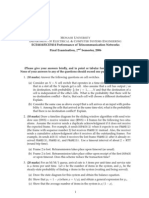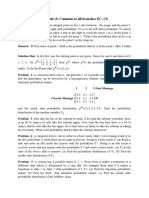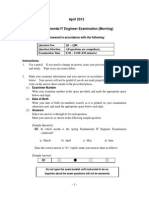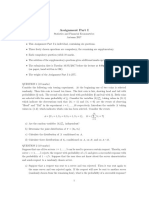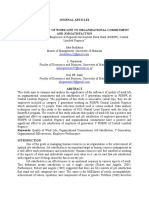Operations Research II: Stochastic Models Practice Final
Operations Research II: Stochastic Models Practice Final
Uploaded by
Eric BrugelCopyright:
Available Formats
Operations Research II: Stochastic Models Practice Final
Operations Research II: Stochastic Models Practice Final
Uploaded by
Eric BrugelOriginal Description:
Original Title
Copyright
Available Formats
Share this document
Did you find this document useful?
Is this content inappropriate?
Copyright:
Available Formats
Operations Research II: Stochastic Models Practice Final
Operations Research II: Stochastic Models Practice Final
Uploaded by
Eric BrugelCopyright:
Available Formats
AMS 342
Joe Mitchell
Operations Research II: Stochastic Models Practice Final
1. (10 points) Consider a discrete-time Markov Chain with transition diagram shown below. The state space is S = {1, 2, 3, . . .}, and an arc indicates a nonzero single-step transition probability.
1 1 2 9 .1/2 3 4 7 8 10 .1/2 1/2 11 .1/2 1/2 0 .1/2 1/2
5 6
(a). (5 points) What are the communicating classes? (b). (5 points) For each state, determine if it is transient, positive recurrent, or null recurrent, and give its period. 2. (6 points) The jobs to be performed on a particular machine arrive according to a Poisson input process with a mean rate of three per hour. Suppose that the machine breaks down and will require (exactly) one hour to be repaired. What is the probability that at least two new jobs will arrive during the repair? 3. (6 points) Consider a renewal process in which the interevent times T i take on values 1, 2, or 3, with probabilities 1/2, 1/4, and 1/4, respectively. What is P {N (3) = 2}? What is P {N (4) N (6) > 2}? 4. (6 points) Consider an M/M/1 queue with arrival rate = 2 per hour and mean service time of 20 minutes. What is the probability that an average customer spends more than 20 minutes (total) in the system (including time in service)? 5. (6 points) Customers arrive to a bank with a single teller at rate 5 per hour. From statistical tests, we determine that the average time a customer waits in line is 27 minutes and that, on average, there are 3 customers (total, including anyone who might be in service) in the bank. What is the average length of time it takes the teller to serve a customer? 6. (12 points) Joe works in a busy AMS oce where students arrive according to a Poisson process with a mean interarrival time of 10 minutes. It takes Joe an amount of time X to serve a student, where X is uniformly distributed between 2 and 6 minutes. Immediately upon completion of a service, Joe takes a coee break, which lasts for a deterministic length of time of length 5 minutes. While Joe is serving a student or while he is on coee break, any arriving students to the oce turn around and go home. (a). (3 points) What fraction of time is Joe working to serve students? (b). (3 points) On the average, how many students per hour does Joe serve? (c). (3 points) What fraction of students that show up at the oce actually end up being served? (d). (3 points) Can this process be modelled as a CTMC? If so, how; if not, why not? 7. (8 points) Babies are born in Stony Brook Hospital in such a way that the time between the i th and (i + 1)st births has a distribution with density g (). The answers to the following questions may be left in terms of integrals. (a). (4 points) At what rate are babies born? (b). (4 points) Let Tlast be the time of the arrival of the last baby in the twentieth century, and let T f irst be the time of the arrival of the rst baby in the twenty-rst century. What is P {Tf irst Tlast > t}? 8. (7 points) Consider a queueing system in which customers arrive in cars according to a Poisson process, with one car arriving on average every 5 minutes. One third of all cars contain a single customer; two thirds contain 2 customers. There are two identical servers, each serving a customer in exponential time with an average service time of 2 minutes. Construct the rate transition diagram for the corresponding CTMC. Dene your states explicitly! 9. (8 points) Suppose that coin A has probability .4 of coming up heads, and that coin B has probability .5 of coming up heads. If the coin ipped today comes up heads, then we select coin A to ip tomorrow, and if it comes up tails, then we select coin B to ip tomorrow. Assume that the coin initially ipped (on day number 0) is equally likely to be coin A or coin B. We wish to model this process as a Markov chain. (a). (2 points) Specically, what is the state space, and what is the interpretation of being in state i at time n? (b). (2 points) What is the single-step transition matrix P? (Label your rows and columns with the states.)
(c). (2 point) What is the probability that the third coin we ip is coin A? (That is, what is the probability that the coin that we ip on day number 2 is coin A?) (d). (2 point) What is the probability that the third coin we ip comes up heads? (That is, what is the probability that the coin that we ip on day number 2 comes up heads?) 10. (6 points) Consider a discrete-time Markov chain on state space S = {0, 1, 2} whose single-step probability transition matrix is given below. 1/2 0 1/2 P = 1/3 1/3 1/3 1/2 1/4 1/4 (a). (2 points) Compute P {X5 = 0 | X3 = 0}. (b). (4 points) Compute P {X2 = X3 | X0 = 0, X4 = 2}. 11. (5 points) Consider a CTMC on state space {0, 1, 2}. The values of the holding time parameters are 0 =??, 1 = 3, 2 =??. The Q matrix is given by ?? 1/2 1 Q = ?? ?? ?? 2 ?? 5 and the jump matrix is given by ?? P J = 1/5 ?? ?? ?? ?? ?? . ?? ??
Fill in all of the blanks where I wrote ??. 12. (20 points) Consider the queueing network shown below, where each box (node) represents a queueing station with innite capacity (unlimited chairs). Assume that each node i of the network has a single server working at exponential rate i (1 = 12, 2 = 3, 3 = 4). Customers that leave node 1 go to node 3 with probability 1/4, while customers that leave node 2 depart the system with probability 1/2. There is a Poisson arrival stream of customers to node 1 with rate 2.
1/2 Poisson rate 2 1 2 3
1/4 (a). (4 points) Assume that the network is currently in the situation of having one customer at node 1, two customers at node 2, and three customers at node 3. What is the probability that the next change in state occurs within the next 4 units of time, but not within the next 2 units of time? (b). (2 points) What is the routing matrix R for the queueing network? (c). (4 points) What are the net eective arrival rates i at each node? (d). (5 points) What is the long-run probability that the network is in the situation of having one customer at node 1, two customers at node 2, and three customers at node 3? (e). (5 points) How would your answer to (d) change is there were an innite number of servers at node 3?
You might also like
- Math Quadratic Equations WorksheetDocument8 pagesMath Quadratic Equations WorksheetSchool Works M100% (5)
- Chapter 2 Solutions Solution Manual Introductory Econometrics For FinanceDocument10 pagesChapter 2 Solutions Solution Manual Introductory Econometrics For FinanceNazim Uddin Mahmud50% (2)
- Exam 2006Document9 pagesExam 2006BobNo ratings yet
- A Detailed Lesson Plan in Basic CalculusDocument5 pagesA Detailed Lesson Plan in Basic CalculusRoxanne Mae Grefiel Daz0% (1)
- Ma2262 Probability and Queuing Theory Question Bank DownloadDocument4 pagesMa2262 Probability and Queuing Theory Question Bank DownloadTaniyaa VenkatNo ratings yet
- New Microsoft Office Word DocumentDocument5 pagesNew Microsoft Office Word DocumentK Selva GaneshNo ratings yet
- Assignment 3Document2 pagesAssignment 3Adil AliNo ratings yet
- PQT QBDocument7 pagesPQT QBSasemohan ChinnasamyNo ratings yet
- Probability and Queuing Theory QPDocument10 pagesProbability and Queuing Theory QPsenthilkumareceNo ratings yet
- Final 6711 F07 SolsDocument4 pagesFinal 6711 F07 SolsSongya PanNo ratings yet
- Ma20106 Aasign Stochastic2016Document4 pagesMa20106 Aasign Stochastic2016Soumajit DuttaNo ratings yet
- All Pi0 Pi1 Pi2: Struct With FieldsDocument8 pagesAll Pi0 Pi1 Pi2: Struct With FieldsJASHWIN GAUTAMNo ratings yet
- PHD Comprehensive Examination Department of Computer Science & EngineeringDocument5 pagesPHD Comprehensive Examination Department of Computer Science & EngineeringSomnath PalNo ratings yet
- CSC 424 Question and AnswerDocument4 pagesCSC 424 Question and AnswerIni UwakmfonNo ratings yet
- Question Paper Code:: Reg. No.Document4 pagesQuestion Paper Code:: Reg. No.Suganthi SuguNo ratings yet
- SMCSDocument7 pagesSMCSrakesh7800_427023020No ratings yet
- Midterm CS433 Key AnswersDocument4 pagesMidterm CS433 Key Answersglories_No ratings yet
- Ise Viii System Modeling and Simulation 06cs82 Sol 240806 065259Document68 pagesIse Viii System Modeling and Simulation 06cs82 Sol 240806 065259anudwivediii007No ratings yet
- ACTL 2003 Stochastic Models For Actuarial Applications Final ExaminationDocument12 pagesACTL 2003 Stochastic Models For Actuarial Applications Final ExaminationBobNo ratings yet
- BJJBDocument8 pagesBJJBDewi silaenNo ratings yet
- Practice Assignment (Markov Chains and Queuing Theory) : N N N NDocument4 pagesPractice Assignment (Markov Chains and Queuing Theory) : N N N NKeshi AngelNo ratings yet
- CSC 369H1 F Operating Systems University of Toronto FALL 2003 Midterm Test No Aids AllowedDocument7 pagesCSC 369H1 F Operating Systems University of Toronto FALL 2003 Midterm Test No Aids AllowedLolo LalaNo ratings yet
- 2006 Exam PaperDocument2 pages2006 Exam PapernicholasiNo ratings yet
- Tutorial (3) Common To All Branches EC, CSDocument2 pagesTutorial (3) Common To All Branches EC, CSJagadeesh ShivaNo ratings yet
- DTMC HomeworkDocument3 pagesDTMC HomeworkYEINER DAVID PAJARO OTERONo ratings yet
- 2013 April (Q)Document32 pages2013 April (Q)WachichaoOahcihawNo ratings yet
- CS433-FINAL-EXAM-FALL2009 (Jar Antrian)Document4 pagesCS433-FINAL-EXAM-FALL2009 (Jar Antrian)Dwi PratiwiNo ratings yet
- PQT Model ExamDocument2 pagesPQT Model ExamBalachandar BalasubramanianNo ratings yet
- Ma2262 - Probability and Queueing Theory PDFDocument3 pagesMa2262 - Probability and Queueing Theory PDFvelkarthi9250% (2)
- Maths Nov - Dec 2010Document3 pagesMaths Nov - Dec 2010Jenitha RajaduraiNo ratings yet
- Tutsheet 10 NewDocument3 pagesTutsheet 10 NewgeologyajNo ratings yet
- Final 6711 F10Document4 pagesFinal 6711 F10Songya PanNo ratings yet
- Assignments 2017 PDFDocument18 pagesAssignments 2017 PDFAbraham SauvingnonNo ratings yet
- 2018 April MA204-C - Ktu QbankDocument2 pages2018 April MA204-C - Ktu QbankJoel JosephNo ratings yet
- Tutsheet 7Document2 pagesTutsheet 7vishnuNo ratings yet
- 1.225 Transportation Flow SystemsDocument12 pages1.225 Transportation Flow Systemsknsmanto-1No ratings yet
- HSTS416 Assignment 2 Sept2002Document5 pagesHSTS416 Assignment 2 Sept2002lynn zigaraNo ratings yet
- Ross Chapter - 6 ExerciseDocument4 pagesRoss Chapter - 6 Exercisebrowniebubble21No ratings yet
- University of Zimbabwe: Time: - HoursDocument2 pagesUniversity of Zimbabwe: Time: - HoursTapiwa AmisiNo ratings yet
- Me Maths ModelDocument2 pagesMe Maths ModelJagan RajendiranNo ratings yet
- Tutsheet 8Document2 pagesTutsheet 8vishnuNo ratings yet
- SOLUTIONS : Midterm Exam For Simulation (CAP 4800)Document14 pagesSOLUTIONS : Midterm Exam For Simulation (CAP 4800)Amit DostNo ratings yet
- Os MCQDocument21 pagesOs MCQgurusodhiiNo ratings yet
- Problem Set 1Document6 pagesProblem Set 1AnushaNo ratings yet
- Act L 2102 Pass Sample MidtermDocument2 pagesAct L 2102 Pass Sample Midtermad_konNo ratings yet
- PQT - Nov - Dec 2007Document6 pagesPQT - Nov - Dec 2007lmsrtNo ratings yet
- SMS Questions SetDocument5 pagesSMS Questions SetRashmisuryaNo ratings yet
- Homework 1,2,3 NetworkDocument3 pagesHomework 1,2,3 NetworkdiosjirehNo ratings yet
- PHD Admissions Test Model Paper 20mayr07Document9 pagesPHD Admissions Test Model Paper 20mayr07anant_nimkar9243No ratings yet
- M.E (Or) QBDocument21 pagesM.E (Or) QBkeerthi_sm180% (1)
- PQTDocument5 pagesPQTDot KidmanNo ratings yet
- An Introduction To Queueing Theory: Many Customers Want To Use A Finite ResourceDocument22 pagesAn Introduction To Queueing Theory: Many Customers Want To Use A Finite Resourceremya_392830015No ratings yet
- Problems in Probability MitDocument3 pagesProblems in Probability MitManoj NanduriNo ratings yet
- Edexcel GCE: Tuesday 19 June 2001 Morning Time: 1 Hour 30 MinutesDocument5 pagesEdexcel GCE: Tuesday 19 June 2001 Morning Time: 1 Hour 30 MinutesMohamed NabeelNo ratings yet
- MA319-7-RT Resit Test PaperDocument3 pagesMA319-7-RT Resit Test PaperMuhammad abdur rehmanNo ratings yet
- ECEN4533 Exam #1 28 February 2011: (Answer: 6,686)Document2 pagesECEN4533 Exam #1 28 February 2011: (Answer: 6,686)tam tranNo ratings yet
- hw4 Stat521spring2019Document2 pageshw4 Stat521spring2019Prof. Madya Dr. Umar Yusuf MadakiNo ratings yet
- 303 NaveenDocument4 pages303 NaveenRashmi GuptaNo ratings yet
- Mind, Body, World: Foundations of Cognitive ScienceFrom EverandMind, Body, World: Foundations of Cognitive ScienceRating: 5 out of 5 stars5/5 (1)
- Analytical Modeling of Wireless Communication SystemsFrom EverandAnalytical Modeling of Wireless Communication SystemsNo ratings yet
- Kinematic Link or Element: Unit-IDocument15 pagesKinematic Link or Element: Unit-IenggsantuNo ratings yet
- Evive Placement Ver4Document6 pagesEvive Placement Ver4Anonymous Nrt5zVrX7No ratings yet
- Journal Articles Jaka BudiatmaDocument19 pagesJournal Articles Jaka BudiatmaMuhammad Rido AbdullahNo ratings yet
- DDL DML DRL TCL DCL Create Table Syntax: Create Table Student (No Number (2), Name Varchar (10), Marks Number (3) )Document206 pagesDDL DML DRL TCL DCL Create Table Syntax: Create Table Student (No Number (2), Name Varchar (10), Marks Number (3) )upendra9999No ratings yet
- 11th Computer Science Chapter 13 Study Material English MediumDocument5 pages11th Computer Science Chapter 13 Study Material English MediumSaro RamNo ratings yet
- Electrokinetics 2012 Propellantless Propulsion - Valone SPESIF Online Elsevier PDFDocument12 pagesElectrokinetics 2012 Propellantless Propulsion - Valone SPESIF Online Elsevier PDFThomas Valone100% (2)
- PlantUML Language Reference Guide en PDFDocument175 pagesPlantUML Language Reference Guide en PDFRadhe Shyam ThakurNo ratings yet
- HC900 Function BlockDocument450 pagesHC900 Function BlockKan ChoraNo ratings yet
- Answer: Option ADocument28 pagesAnswer: Option ADhananjay KadamNo ratings yet
- Bouncy SensorDocument137 pagesBouncy SensorJagadesh BabuNo ratings yet
- Batch Distillation of Water-Methanol SystemDocument78 pagesBatch Distillation of Water-Methanol Systemsatadruc50% (4)
- Modeling Control and Simulation of Two Axes Gimbal Seeker Using Fuzzy PID Controller PDFDocument6 pagesModeling Control and Simulation of Two Axes Gimbal Seeker Using Fuzzy PID Controller PDFFaisal Khan JadoonNo ratings yet
- Fundamental Algorithms, Assignment 4 SolutionsDocument3 pagesFundamental Algorithms, Assignment 4 SolutionsAashish DNo ratings yet
- Mec 1Document4 pagesMec 1aadityaNo ratings yet
- HmmorganDocument26 pagesHmmorganjongoggogNo ratings yet
- DirectX TutorialDocument128 pagesDirectX Tutorialsilly_rabbitzNo ratings yet
- CL - 6 - UIMO-2023-Paper-9264 KeyDocument6 pagesCL - 6 - UIMO-2023-Paper-9264 KeyShashwat SinghNo ratings yet
- Aljabar 2Document20 pagesAljabar 2Alfarizi Bay HaqiNo ratings yet
- LsppscriptingDocument30 pagesLsppscriptingimechanicaNo ratings yet
- Tutorial 9Document1 pageTutorial 9Nur AqilahNo ratings yet
- 18ENG15 - Module 03Document32 pages18ENG15 - Module 03Prasidh Umesh ShettyNo ratings yet
- Objectives:: The General Form of The Yokogawa Cs3000 and Centumvp Pid ControllersDocument2 pagesObjectives:: The General Form of The Yokogawa Cs3000 and Centumvp Pid ControllersSudeep MukherjeeNo ratings yet
- Type How To Carry Out Advantages Disadvantages: Simple Random SamplingDocument1 pageType How To Carry Out Advantages Disadvantages: Simple Random SamplingAmir PoustiNo ratings yet
- CS480 Lecture November 14thDocument72 pagesCS480 Lecture November 14thRajeswariNo ratings yet
- Math 7 - Q2 - M7Document14 pagesMath 7 - Q2 - M7Renalyn BalisiNo ratings yet
- Chapter 9: Marketing Information SystemsDocument10 pagesChapter 9: Marketing Information SystemsHari NaghuNo ratings yet
- RP Lecture8Document18 pagesRP Lecture8stipe1pNo ratings yet






















